tires MAZDA MODEL RX 8 2007 Owners Manual (in English)
[x] Cancel search | Manufacturer: MAZDA, Model Year: 2007, Model line: MODEL RX 8, Model: MAZDA MODEL RX 8 2007Pages: 443
Page 12 of 443

Black plate (11,1)
Trunk lid ............................................................................................................ page 3-33
Rear window defroster ....................................................................................... page 5-60
Antenna ............................................................................................................. page 6-10
Power windows ................................................................................................. page 3-37
Outside mirror .................................................................................................... page 3-53
Tires ................................................................................................................... page 8-24
Light bulbs ......................................................................................................... page 8-29
Hood .................................................................................................................. page 3-42
Windshield wiper blades .................................................................................... page 8-19
Moonroof ........................................................................................................... page 3-43
Fuel-filler lid ...................................................................................................... page 3-40
Doors and keys .................................................................................................. page 3-29
Your Vehicle at a Glance
Exterior Overview
1-5
RX-8_8V89-EA-06F_Edition1 Page11
Friday, May 19 2006 9:50 AM
Form No.8V89-EA-06F
Page 127 of 443
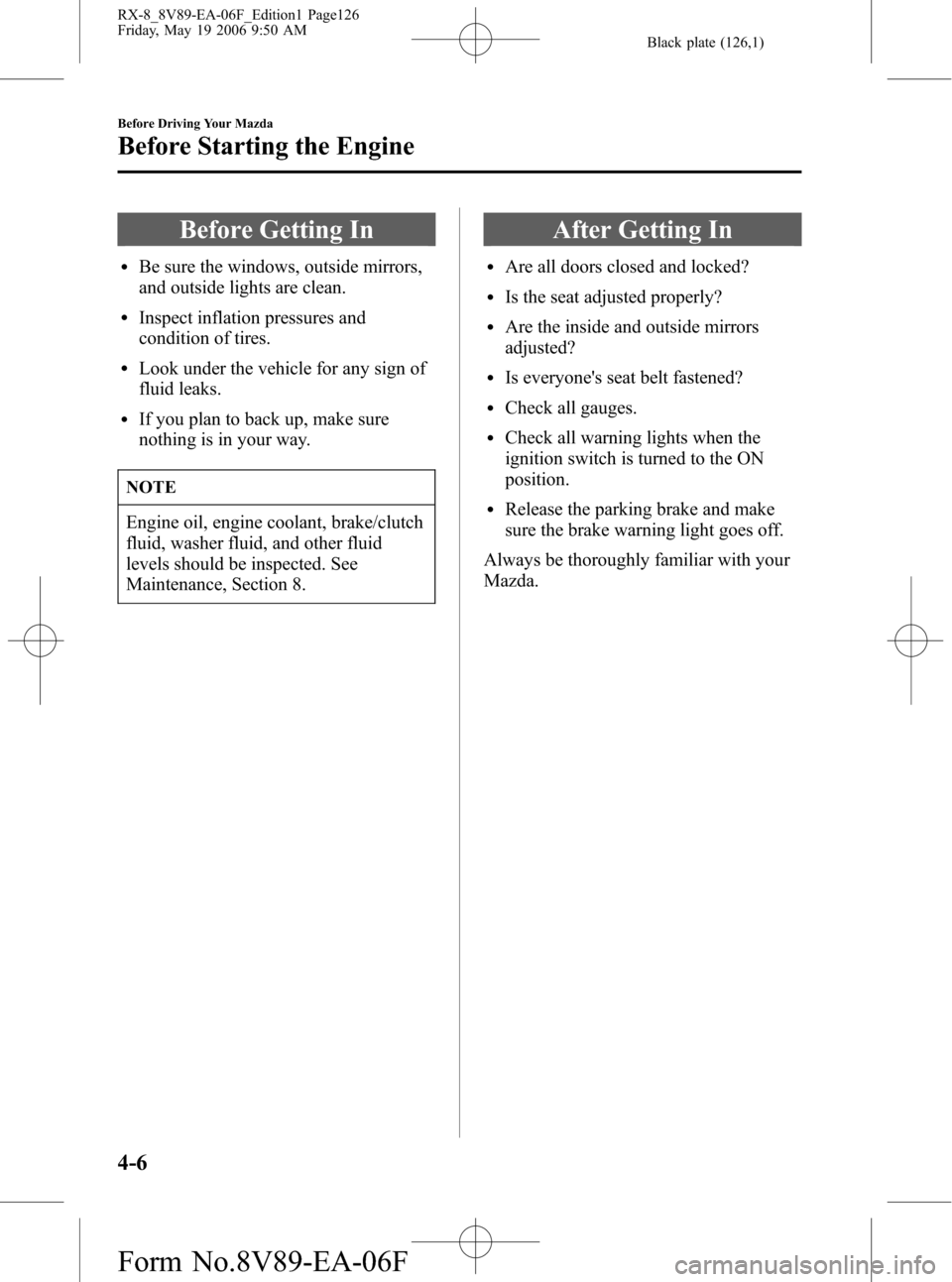
Black plate (126,1)
Before Getting In
lBe sure the windows, outside mirrors,
and outside lights are clean.
lInspect inflation pressures and
condition of tires.
lLook under the vehicle for any sign of
fluid leaks.
lIf you plan to back up, make sure
nothing is in your way.
NOTE
Engine oil, engine coolant, brake/clutch
fluid, washer fluid, and other fluid
levels should be inspected. See
Maintenance, Section 8.
After Getting In
lAre all doors closed and locked?
lIs the seat adjusted properly?
lAre the inside and outside mirrors
adjusted?
lIs everyone's seat belt fastened?
lCheck all gauges.
lCheck all warning lights when the
ignition switch is turned to the ON
position.
lRelease the parking brake and make
sure the brake warning light goes off.
Always be thoroughly familiar with your
Mazda.
4-6
Before Driving Your Mazda
Before Starting the Engine
RX-8_8V89-EA-06F_Edition1 Page126
Friday, May 19 2006 9:50 AM
Form No.8V89-EA-06F
Page 128 of 443
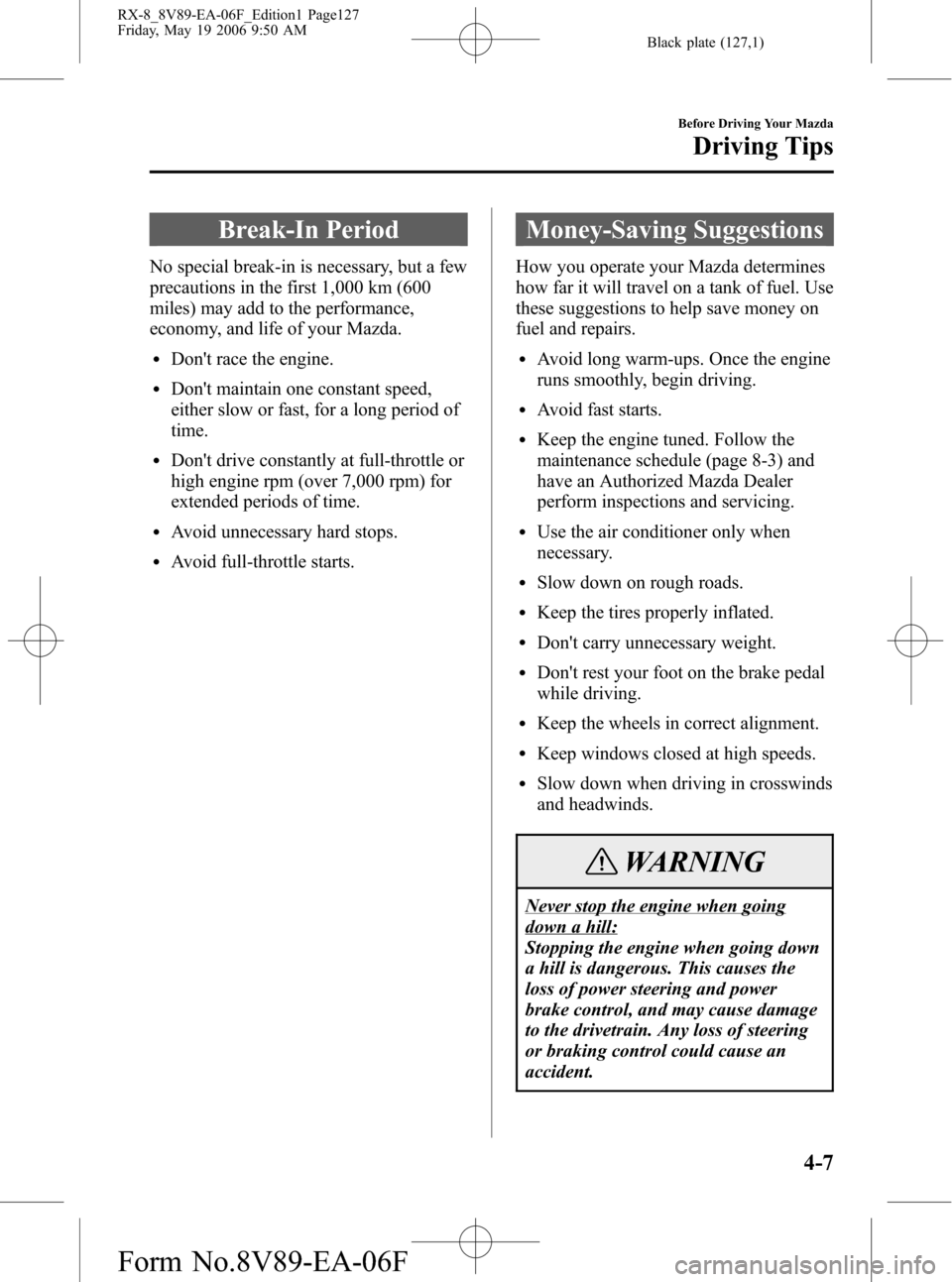
Black plate (127,1)
Break-In Period
No special break-in is necessary, but a few
precautions in the first 1,000 km (600
miles) may add to the performance,
economy, and life of your Mazda.
lDon't race the engine.
lDon't maintain one constant speed,
either slow or fast, for a long period of
time.
lDon't drive constantly at full-throttle or
high engine rpm (over 7,000 rpm) for
extended periods of time.
lAvoid unnecessary hard stops.
lAvoid full-throttle starts.
Money-Saving Suggestions
How you operate your Mazda determines
how far it will travel on a tank of fuel. Use
these suggestions to help save money on
fuel and repairs.
lAvoid long warm-ups. Once the engine
runs smoothly, begin driving.
lAvoid fast starts.
lKeep the engine tuned. Follow the
maintenance schedule (page 8-3) and
have an Authorized Mazda Dealer
perform inspections and servicing.
lUse the air conditioner only when
necessary.
lSlow down on rough roads.
lKeep the tires properly inflated.
lDon't carry unnecessary weight.
lDon't rest your foot on the brake pedal
while driving.
lKeep the wheels in correct alignment.
lKeep windows closed at high speeds.
lSlow down when driving in crosswinds
and headwinds.
WARNING
Never stop the engine when going
down a hill:
Stopping the engine when going down
a hill is dangerous. This causes the
loss of power steering and power
brake control, and may cause damage
to the drivetrain. Any loss of steering
or braking control could cause an
accident.
Before Driving Your Mazda
Driving Tips
4-7
RX-8_8V89-EA-06F_Edition1 Page127
Friday, May 19 2006 9:50 AM
Form No.8V89-EA-06F
Page 129 of 443
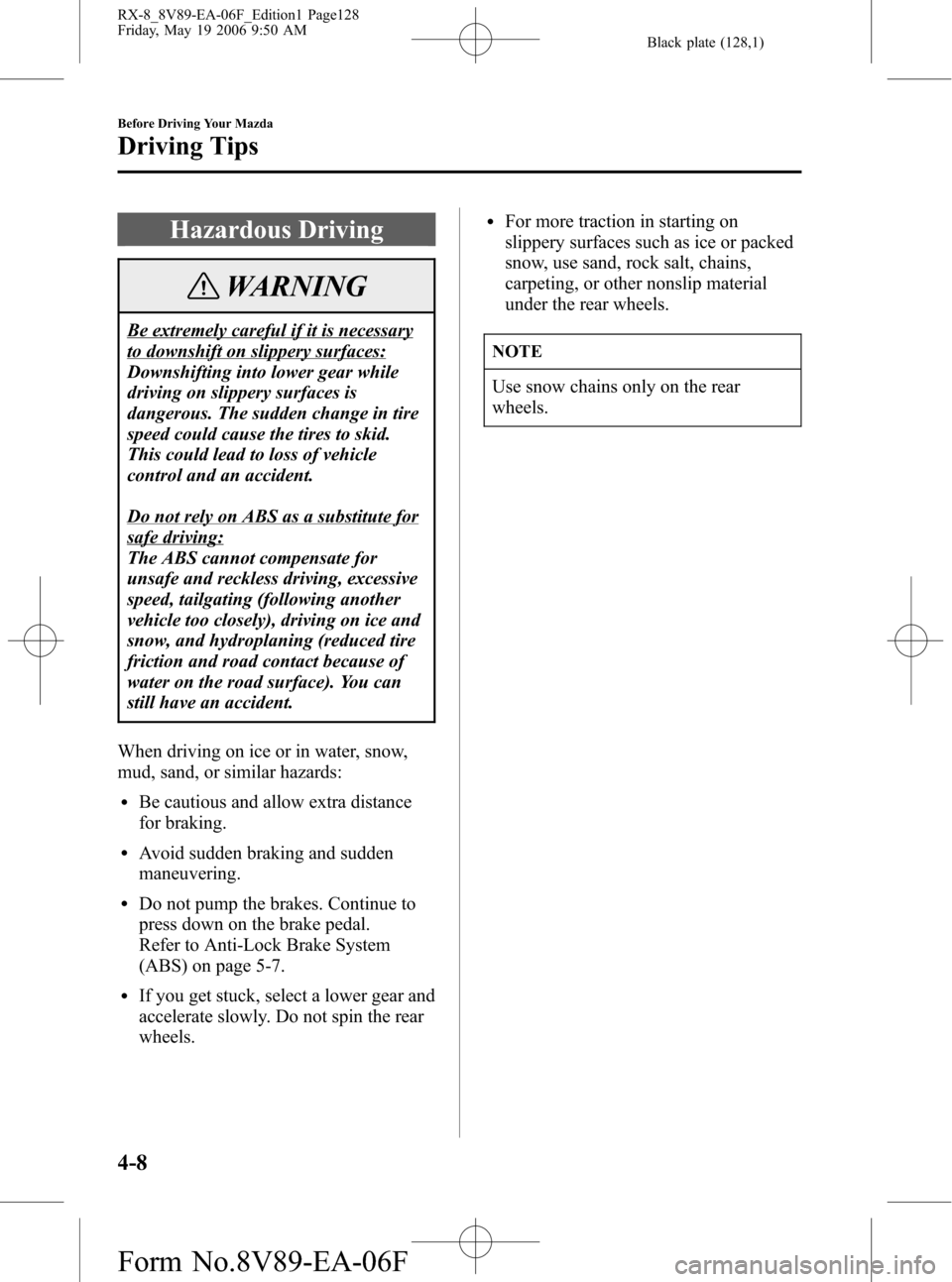
Black plate (128,1)
Hazardous Driving
WARNING
Be extremely careful if it is necessary
to downshift on slippery surfaces:
Downshifting into lower gear while
driving on slippery surfaces is
dangerous. The sudden change in tire
speed could cause the tires to skid.
This could lead to loss of vehicle
control and an accident.
Do not rely on ABS as a substitute for
safe driving:
The ABS cannot compensate for
unsafe and reckless driving, excessive
speed, tailgating (following another
vehicle too closely), driving on ice and
snow, and hydroplaning (reduced tire
friction and road contact because of
water on the road surface). You can
still have an accident.
When driving on ice or in water, snow,
mud, sand, or similar hazards:
lBe cautious and allow extra distance
for braking.
lAvoid sudden braking and sudden
maneuvering.
lDo not pump the brakes. Continue to
press down on the brake pedal.
Refer to Anti-Lock Brake System
(ABS) on page 5-7.
lIf you get stuck, select a lower gear and
accelerate slowly. Do not spin the rear
wheels.
lFor more traction in starting on
slippery surfaces such as ice or packed
snow, use sand, rock salt, chains,
carpeting, or other nonslip material
under the rear wheels.
NOTE
Use snow chains only on the rear
wheels.
4-8
Before Driving Your Mazda
Driving Tips
RX-8_8V89-EA-06F_Edition1 Page128
Friday, May 19 2006 9:50 AM
Form No.8V89-EA-06F
Page 131 of 443
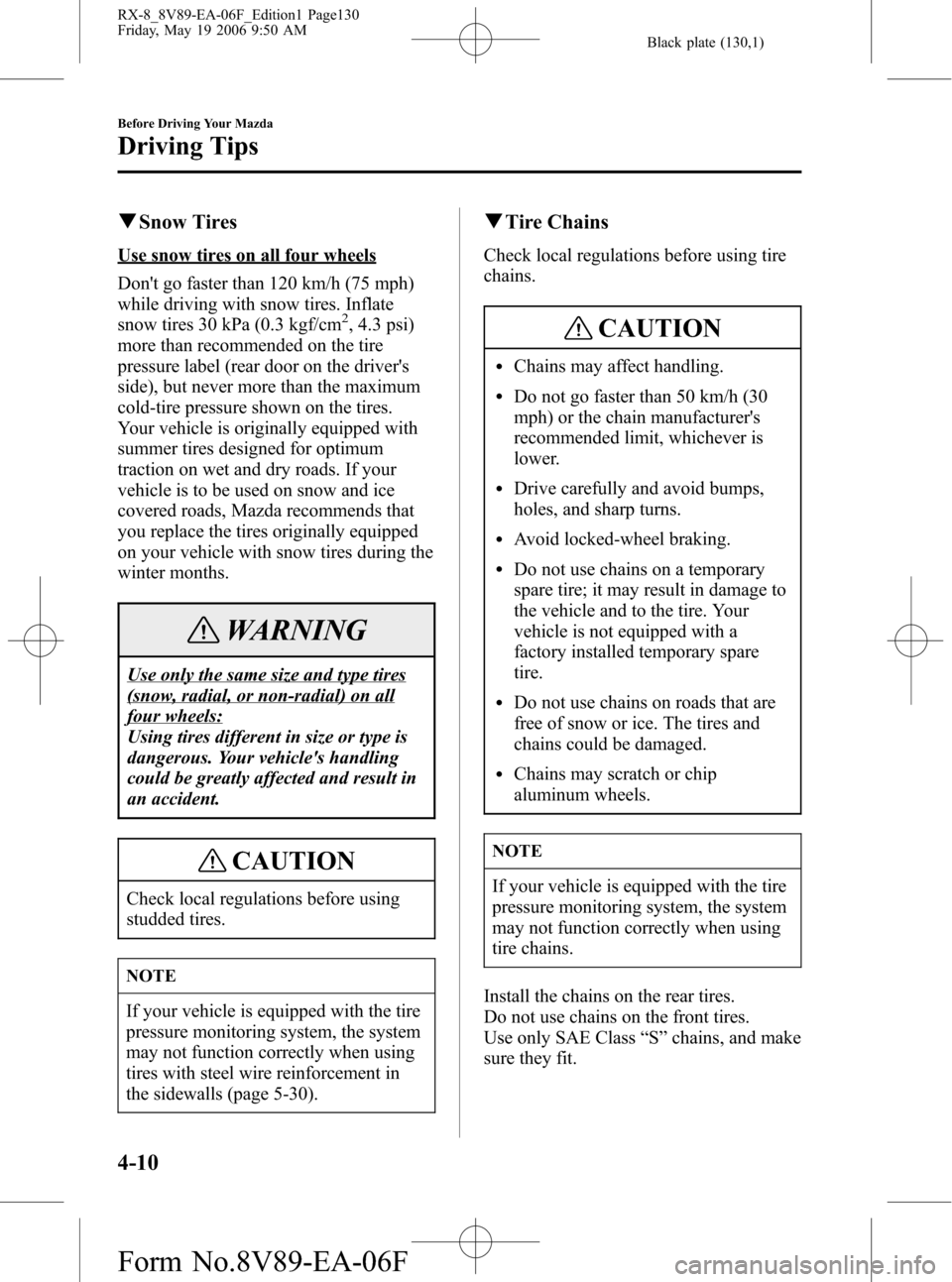
Black plate (130,1)
qSnow Tires
Use snow tires on all four wheels
Don't go faster than 120 km/h (75 mph)
while driving with snow tires. Inflate
snow tires 30 kPa (0.3 kgf/cm
2, 4.3 psi)
more than recommended on the tire
pressure label (rear door on the driver's
side), but never more than the maximum
cold-tire pressure shown on the tires.
Your vehicle is originally equipped with
summer tires designed for optimum
traction on wet and dry roads. If your
vehicle is to be used on snow and ice
covered roads, Mazda recommends that
you replace the tires originally equipped
on your vehicle with snow tires during the
winter months.
WARNING
Use only the same size and type tires
(snow, radial, or non-radial) on all
four wheels:
Using tires different in size or type is
dangerous. Your vehicle's handling
could be greatly affected and result in
an accident.
CAUTION
Check local regulations before using
studded tires.
NOTE
If your vehicle is equipped with the tire
pressure monitoring system, the system
may not function correctly when using
tires with steel wire reinforcement in
the sidewalls (page 5-30).
qTire Chains
Check local regulations before using tire
chains.
CAUTION
lChains may affect handling.
lDo not go faster than 50 km/h (30
mph) or the chain manufacturer's
recommended limit, whichever is
lower.
lDrive carefully and avoid bumps,
holes, and sharp turns.
lAvoid locked-wheel braking.
lDo not use chains on a temporary
spare tire; it may result in damage to
the vehicle and to the tire. Your
vehicle is not equipped with a
factory installed temporary spare
tire.
lDo not use chains on roads that are
free of snow or ice. The tires and
chains could be damaged.
lChains may scratch or chip
aluminum wheels.
NOTE
If your vehicle is equipped with the tire
pressure monitoring system, the system
may not function correctly when using
tire chains.
Install the chains on the rear tires.
Do not use chains on the front tires.
Use only SAE Class“S”chains, and make
sure they fit.
4-10
Before Driving Your Mazda
Driving Tips
RX-8_8V89-EA-06F_Edition1 Page130
Friday, May 19 2006 9:50 AM
Form No.8V89-EA-06F
Page 132 of 443
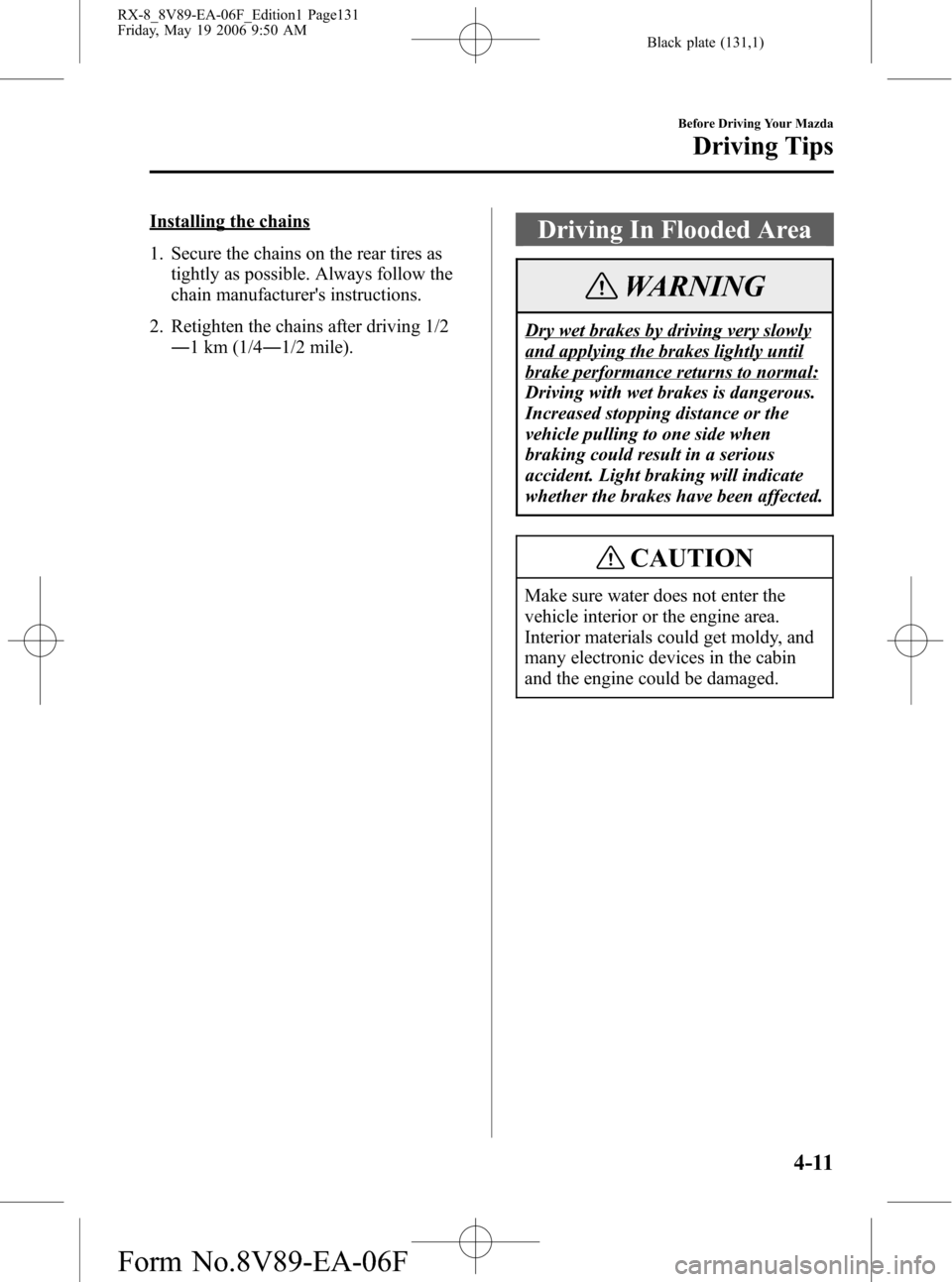
Black plate (131,1)
Installing the chains
1. Secure the chains on the rear tires as
tightly as possible. Always follow the
chain manufacturer's instructions.
2. Retighten the chains after driving 1/2
―1 km (1/4―1/2 mile).Driving In Flooded Area
WARNING
Dry wet brakes by driving very slowly
and applying the brakes lightly until
brake performance returns to normal:
Driving with wet brakes is dangerous.
Increased stopping distance or the
vehicle pulling to one side when
braking could result in a serious
accident. Light braking will indicate
whether the brakes have been affected.
CAUTION
Make sure water does not enter the
vehicle interior or the engine area.
Interior materials could get moldy, and
many electronic devices in the cabin
and the engine could be damaged.
Before Driving Your Mazda
Driving Tips
4-11
RX-8_8V89-EA-06F_Edition1 Page131
Friday, May 19 2006 9:50 AM
Form No.8V89-EA-06F
Page 142 of 443
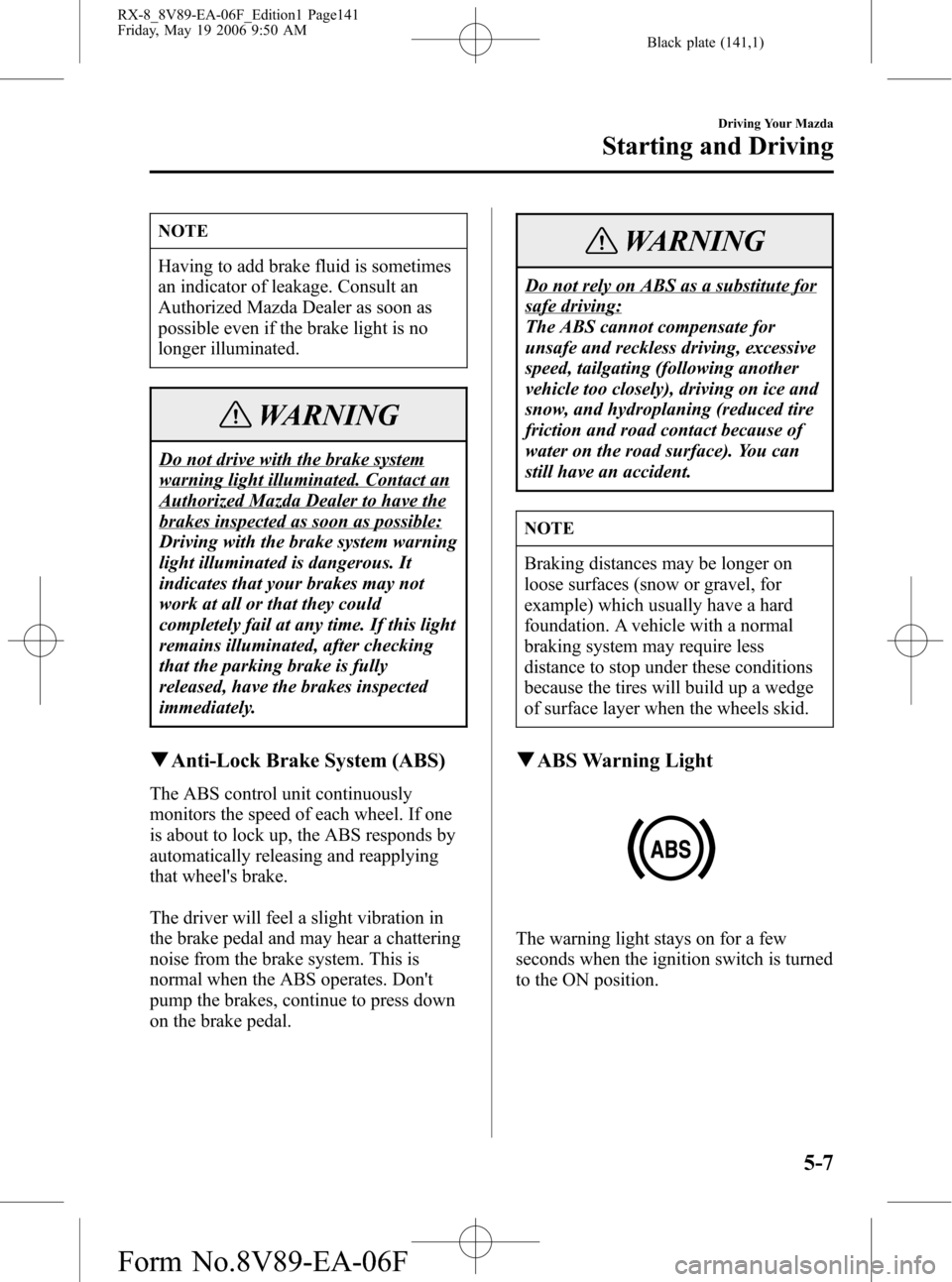
Black plate (141,1)
NOTE
Having to add brake fluid is sometimes
an indicator of leakage. Consult an
Authorized Mazda Dealer as soon as
possible even if the brake light is no
longer illuminated.
WARNING
Do not drive with the brake system
warning light illuminated. Contact an
Authorized Mazda Dealer to have the
brakes inspected as soon as possible:
Driving with the brake system warning
light illuminated is dangerous. It
indicates that your brakes may not
work at all or that they could
completely fail at any time. If this light
remains illuminated, after checking
that the parking brake is fully
released, have the brakes inspected
immediately.
qAnti-Lock Brake System (ABS)
The ABS control unit continuously
monitors the speed of each wheel. If one
is about to lock up, the ABS responds by
automatically releasing and reapplying
that wheel's brake.
The driver will feel a slight vibration in
the brake pedal and may hear a chattering
noise from the brake system. This is
normal when the ABS operates. Don't
pump the brakes, continue to press down
on the brake pedal.
WARNING
Do not rely on ABS as a substitute for
safe driving:
The ABS cannot compensate for
unsafe and reckless driving, excessive
speed, tailgating (following another
vehicle too closely), driving on ice and
snow, and hydroplaning (reduced tire
friction and road contact because of
water on the road surface). You can
still have an accident.
NOTE
Braking distances may be longer on
loose surfaces (snow or gravel, for
example) which usually have a hard
foundation. A vehicle with a normal
braking system may require less
distance to stop under these conditions
because the tires will build up a wedge
of surface layer when the wheels skid.
qABS Warning Light
The warning light stays on for a few
seconds when the ignition switch is turned
to the ON position.
Driving Your Mazda
Starting and Driving
5-7
RX-8_8V89-EA-06F_Edition1 Page141
Friday, May 19 2006 9:50 AM
Form No.8V89-EA-06F
Page 145 of 443

Black plate (144,1)
WARNING
Do not use sudden engine braking on
slippery road surfaces or at high
speeds:
Shifting down while driving on wet,
snowy, or frozen roads, or while
driving at high speeds causes sudden
engine braking, which is dangerous.
The sudden change in tire speed could
cause the tires to skid. This could lead
to loss of vehicle control and an
accident.
Be sure to leave the shift lever in 1 or
R position and set the parking brake
when leaving the vehicle unattended:
Otherwise the vehicle could move and
cause an accident.
CAUTION
lKeep your foot off the clutch pedal
except when shifting gears. Also,
don't use the clutch to hold the
vehicle on an upgrade. Riding the
clutch will cause needless clutch
wear and damage.
lMake sure the vehicle comes to a
complete stop before shifting to R.
Shifting to R while the vehicle is still
moving may damage the
transmission.
NOTE
If shifting to R is difficult, shift back
into neutral, release the clutch pedal,
and try again.
qRecommendations for Shifting
Upshifting
For normal acceleration, we recommend
these shift points.
Gear Vehicle speed
1 to 2 23 km/h (14 mph)
2 to 3 35 km/h (22 mph)
3 to 4 47 km/h (29 mph)
4 to 5 58 km/h (36 mph)
5 to 6 74 km/h (46 mph)
For cruising
Gear Vehicle speed
1 to 2 23 km/h (14 mph)
2 to 3 34 km/h (21 mph)
3 to 4 45 km/h (28 mph)
4 to 5 56 km/h (35 mph)
5 to 6 68 km/h (42 mph)
Downshifting
When you must slow down in heavy
traffic or on a steepupgrade, downshift
before the engine starts to overwork. This
reduces the chance of stalling and gives
better acceleration when you need more
speed.
On a steepdowngrade, downshifting
helps maintain safe speed and prolongs
brake life.
5-10
Driving Your Mazda
Starting and Driving
RX-8_8V89-EA-06F_Edition1 Page144
Friday, May 19 2006 9:51 AM
Form No.8V89-EA-06F
Page 151 of 443

Black plate (150,1)
Manually Shifting down
(M6→M5→M4→M3→M2→M1)
To shift down to a lower gear, tap the shift
lever forward (
) once.
To shift down to a lower gear with the
steering shift switches, press either of the
DOWN switches away from you once
with your thumb.
DOWN switches
WARNING
Do not use engine braking on slippery
road surfaces or at high speeds:
Shifting down while driving on wet,
snowy, or frozen roads, or while
driving at high speeds causes sudden
engine braking, which is dangerous.
The sudden change in tire speed could
cause the tires to skid. This could lead
to loss of vehicle control and an
accident.
Keep your hands on the steering wheel
rim when using fingers or thumbs on
the steering shift switches:
Putting your hands inside the rim of
the steering wheel when using the
steering shift switches is dangerous. If
the driver air bag were to deploy in a
collision, your hands could be
impacted causing injury.
NOTE
lWhen driving at high speeds, the
gear may not shift down depending
on vehicle speed.
lDuring deceleration, the gear may
automatically shift down depending
on vehicle speed.
lWhen depressing the accelerator
fully, the transmission will shift to a
lower gear, depending on vehicle
speed.
5-16
Driving Your Mazda
Starting and Driving
RX-8_8V89-EA-06F_Edition1 Page150
Friday, May 19 2006 9:51 AM
Form No.8V89-EA-06F
Page 158 of 443

Black plate (157,1)
Traction Control System
(TCS)
í
The Traction Control System (TCS)
enhances traction and safety by
controlling engine torque and braking.
When the TCS detects driving wheel
slippage, it lowers engine torque and
operates the brakes to prevent loss of
traction.
This means that on a slick surface, the
engine adjusts automatically to provide
optimum power to the drive wheels
without causing them to spin and lose
traction.
WARNING
Do not rely on the traction control
system as a substitute for safe driving:
The traction control system (TCS)
cannot compensate for unsafe and
reckless driving, excessive speed,
tailgating (following another vehicle
too closely), and hydroplaning
(reduced tire friction and road contact
because of water on the road surface).
You can still have an accident.
Use snow tires or tire chains and drive
at reduced speeds when roads are
covered with ice and/or snow:
Driving without proper traction
devices on snow and/or ice-covered
roads is dangerous. The traction
control system (TCS) alone cannot
provide adequate traction and you
could still have an accident.
NOTE
To turn off the TCS, press the DSC
OFF switch (page 5-26).
qTCS/DSC Indicator Light
This indicator light stays on for a few
seconds when the ignition switch is turned
to the ON position. If the TCS or DSC is
operating, the indicator light flashes.
If the light stays on, the TCS or DSC may
have a malfunction and they may not
operate correctly. Take your vehicle to an
Authorized Mazda Dealer.
NOTE
lIn addition to the indicator light
flashing, a slight lugging sound will
come from the engine. This indicates
that the TCS is operating properly.
lOn slippery surfaces, such as fresh
snow, it will be impossible to
achieve high rpm when the TCS is
on.
Driving Your Mazda
Starting and Driving
5-23íSome models. RX-8_8V89-EA-06F_Edition1 Page157
Friday, May 19 2006 9:51 AM
Form No.8V89-EA-06F